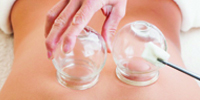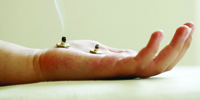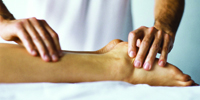
What is acupuncture?
Acupuncture is an ancient form of healing that developed over several thousands of years, in the main in China, but also Japan and throughout the Far East. At the roots of Chinese medicine it is theorised that there exists in the body a system of channels that integrate all the body’s separate parts and functions into a unified organism. The insertion of fine needles along these channels, stimulates the body to rebalance itself, encouraging homoeostasis (maintaining our internal systems in a state of equilibrium). In the Far East acupuncture still features in mainstream healthcare, both as a stand alone therapy and in combination with Western medicine.
What can acupuncture treat?
In the West acupuncture is associated with pain relief and addiction problems, though in fact there are few conditions that acupuncture has not been used to treat. In 1996 The World Health Organisation published its findings of diseases, symptoms or conditions for which acupuncture has been proved through clinical trials to effectively treat, they are:
- Adverse reactions to radiotherapy and/or chemotherapy
- Allergic rhinitis (including hay fever)
- Biliary colic
- Depression (including depressive neurosis and depression following stroke)
- Dysentery, acute bacillary
- Dysmenorrhoea, primary
- Epigastralgia, acute (in peptic ulcer, acute and chronic gastritis, and gastrospasm)
- Facial pain (including craniomandibular disorders)
- Headache
- Hypertension, essential
- Hypotension, primary
- Induction of labour
- Knee pain
- Leukopenia
- Low back pain
- Malposition of foetus
- Morning sickness
- Nausea and vomiting
- Neck pain
- Pain in dentistry (including dental pain and temporomandibular dysfunction)
- Periarthritis of shoulder
- Postoperative pain
- Renal colic
- Rheumatoid arthritis
- Sciatica
- Sprain
- Stroke
- Tennis elbow
The BAcC website has research fact sheets concerning an a-to-z of conditions treated with acupuncture:
http://www.acupuncture.org.uk/category/a-to-z-of-conditions/a-to-z-of-conditions.html
Who has acupuncture?
Many people come for treatment to help with specific symptoms or to relieve pain, though acupuncture is used also by patients who have no obvious diagnosis but feel generally unwell. Others use acupuncture simply to enhance their feeling of wellbeing.
Can acupuncture treat babies and children?
Acupuncture is considered suitable for all ages, including babies and children. Often practitioners will forgo the use of needles for the very young, and use acupressure and/or other methods of treatment. Here is a link to view regarding pediatric treatment.
Is it safe?
Two independent surveys published in the British Medical Journal in 2001 concluded that the risk of serious adverse reaction to acupuncture is less than 1 in 1000.
Should I inform my Doctor?
If your doctor has prescribed you medication it is recommended that you tell your doctor that you plan to have acupuncture. Do not stop taking your medication. Always tell your acupuncturist about any supplements and/or medication that you are taking, as this can affect the response you have to treatment. BAcC acupuncturists are trained to recognise serious underlying health conditions, and if they consider it appropriate they may refer you to your general practioner (GP).
What does it feel like?
The needles used in an acupuncture treatment are very fine, much thinner than those used for injections or taking blood. Patients vary in their response to needle insertion, some do not feel them at all, while others can feel a mild discomfort which generally eases. There can be a sensation of tingling or dull ache.
What should I wear?
You can dress as you choose. Once a diagnosis and treatment plan has been formed, the practitioner may need you to remove some of your clothing in order to uncover areas of the body to insert the needles. Trousers that roll above the knees, and for ladies socks rather than tights or stockings is advisable, however not a problem.
Is acupuncture covered by healthcare insurers?
Cover may be limited but acupuncture is covered by many health insurers.
What is cupping?
Cupping is where sterilised glass cups that vary in size, are warmed and placed on the skin. The heat and speed at which the cups are placed on the skin causes a vaccum, this draws on the skin and has the ability to penetrate deeper into the soft tissue and to the channel level. This can encourage the movement of lymphatic fluid, the removal of toxins, the relaxation of muscles, the easing of joints, and to strengthen immune function. Sometimes a cup may be placed over a needle.



